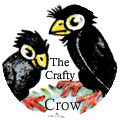Sea Salt vs Table Salt

Just a quick post with a couple links to some well-written articles about sea salt that have given me something to think about recently. Paul parents are in from England for a visit right now, so it's harder to find time to post, but I'm hoping to get a post up soon about our trip to the WV State Wildlife Center.
Somewhere along the way, I must have heard that sea salt is better for you than regular table salt. I knew this so I've bought sea salt the last couple times I was able to visit a bulk foods store. But I really wasn't sure why it was different--the stuff I buy looks just like table salt. Then there's Kosher salt, and I've got some cheese salt in the cupboard for making my cheeses. There's also a box of salt to use for canning foods. It all gets a bit confusing.
This weekend, we stopped at the bulk foods store on our way home from the Wildlife Center. I love poking around there and picking up things I can't get in town, but I don't get there frequently because it's over an hour from home in a direction that I normally don't have reason to travel. So when we do pass that direction, I generally try to stop there. This time, I picked up some whole grains to use with my grain mill and some soy flour to use in the next HBin5 bread which is gluten free. Then I remembered we were very low on sea salt, so I went to get some more of it. I noticed a funny colored salt labeled sea salt next to the little tub of white salt that looked just like table salt, but labeled sea salt. I wondered what the difference was between the sea salts and even between the table salt and sea salt, but didn't have any answers. The funny colored stuff was more expensive and looked kind of dirty. I went for the white stuff, but still wondered about it. Then this morning I came across a couple of articles about sea salt and its benefits. Interesting reads!
As it turns out, I should have tried the more expensive stuff. The reason it looks "dirty" is that it is full of the natural minerals salt is made of before it is stripped and refined to the stuff we are used to seeing on the table. Sea salts come in a rainbow of colors as illustrated by the sea salt sampler pictured at the top of this post. The processing of salt removes all the good stuff that it comes with to the point that iodine has to be reintroduced to the salt. Sea salt has iodine naturally occurring in the minute bits of sea life that are left intact with sun-drying. It seems clumpy because it doesn't have additives to help it pour smoothly. Some sea salts have been processed almost as much as regular table salt, so the benefits of sea salt are essentially gone--like the stuff I bought!
Check out these links to read a bit more about it. I'm going to be doing some more reading on this subject myself and would love to hear your take on the salt issue. Do you take a side in the sea salt vs. table salt debate?















2 comments:
For my table salt I use sea salt.
I haven't experimented with some of the fancier ones but would like to.
We use sea salt for the table and the finer ordinary salt for cooking. We have a clear plastic grinder for the sea salt which is refillable and we prefer the taste of sea salt than the processed salt. Thanks for an interesting post.
Post a Comment